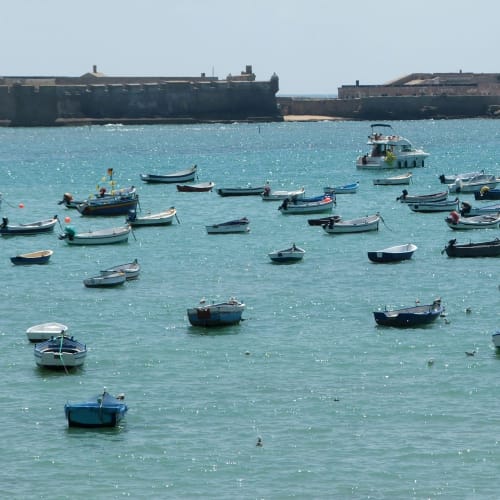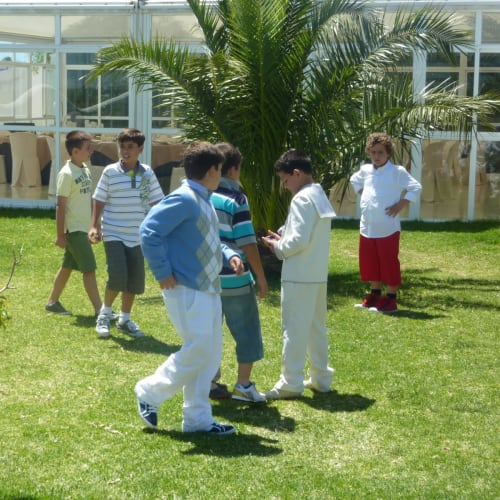Three Kings Sale - Up to 40% Off! Shop Sale
Worth Their Salt in Cádiz
January 2011




Salina San Vicente is the last remnant of a culture that stretches back three thousand years to a time when the Phoenicians plied the Mediterranean Sea, establishing settlements as far away as the Atlantic shores of Cádiz.
Civilizations as old as Tartars, Phoenicians and later the Romans located small salt flats of about 60 acres in diameter in the Bay of Cádiz to take advantage of the constant and strong levante winds from the hot Sahara desert of Africa that greatly facilitate the evaporation of seawater.
Today, Manolo Ruiz and his wife Reglín work to produce sea salt with their five children: Manuel, Angeles, Lidia, Aurelio and Reglín. They can continue to live the traditional life because their remaining patch of the 3,000 year old salt flats is now set aside as a national park.
They are the fourth generation of the Ruiz family to work with the Salina San Vicente and ten other auxiliary salt fields above the Bay of Cádiz. Manolo’s grandfather, José Ruiz Belizón, a native of northern Spain, was the first owner of this salt enterprise, and his son José Ruiz Velázquez expanded their holdings.
We must have driven by the salt flats of the Bay of Cádiz a hundred times over the past forty years, but we never had the opportunity to investigate this ancient site until my son Tim made contact with Manolo and Reglín Ruiz during his extended stay with his family in neighboring El Puerto de Santa María.
One Sunday last May, our family spent much of the day with Manolo Ruiz as we stood on the banks of the salt evaporating reservoirs of this desolate region. Not only had we come to meet him, but also to witness a reenactment of the traditional Estero salt harvest festival. The authentic celebration occurs every year in late summer when the harvest of salt is complete.
This day the occasion was in celebration of a young boy’s First Communion. The boy’s family accompanied him from mass at their parish church to the salt flats of Salinas San Vicente along with many cousins, uncles, aunts and grandparents. He was easy for us to spot as he sat by the fish netting pool in his white sailor suit and blue neckerchief. Naval attire is for some reason the boy’s traditional dress for this holy occasion; girls wear white dresses like bridesmaids.
Like the estero, the principal evaporating pool at the end of the season, this special pool contained fish that surprisingly breed in this very salty environment. With a fishing net spread between them, a couple of workers captured the remaining pool of dorado (sea bream), sea bass and sole. Close by, in the Ruiz ranch house, or finca, a charcoal fire was ready, garnished by aromatic plants from the several reservoirs. They quickly pop the freshly caught live fish on the hot grill, while the rest of the people watch with anticipation and enjoy each other’s company amid copas of fino sherry and tapas including olives, shellfish and Manchego cheese. They then retire inside for a feast.
Although Manolo and Reglín enjoy hosting various celebrations for happy children and proud parents who visit their finca, it is no more than a pleasant diversion for them. Harvesting salt is Manolo’s main concern and he is troubled there are only six families remaining to harvest salt in the Bay of Cádiz. Only twenty years ago, there were 600.
While listening to Manolo’s account I could see that the salt flats are indeed vanishing. As I looked across the desolate salt flats, I could plainly see the encroaching high-rise structures of the city – still a safe distance away.
The story of how the salt flats are used begins with the accumulation of extremely fine silt from the bay of Cádiz into the channel of San Fernando. The silt makes such a dense clay that it can serve as the watertight foundation to accumulate reservoirs of tidal water that flows into the evaporating trays or pools. Some of the confining walls remain from Roman times.
For about three hundred years, the San Fernando channel served as a shipbuilding site where hundreds of wooden ships built for the Armada were anchored. Napoleon’s army was stopped at the shore of San Fernando, since his army found traversing across the flats almost impossible. After the demise of the wooden boat shipyards, the only boats that still plied the channels were wooden salt boats that took their load to far away places, including Galicia. But that ended about 60 years ago.
Two images remain in my mind as I think back on our visit. First was the sight of an intact wooden hulk impregnated with salt pulled up along the edge of the channel. Beyond it was a salt mill built in 1936 during the time of the Civil War. As in the case of the boat, the building was made only of wood, which resists corrosion. In this case, the structure was made from driftwood, as it was the only available source during the Civil War.
To harvest the salt, incoming briny water from the Bay of Cádiz is channeled into elongated ponds, where the seawater remains for about six weeks. The purpose is to concentrate the salt through evaporation and to precipitate different salts. Seawater contains many substances other than sodium chloride and in this traditional method salt acts as a natural purifier – a filter that extracts only the most beneficial water from the sea. Manolo explained that during the natural process, the heavy metals and other contaminants settle out, leaving a clean hyper saline water which will ultimately produce flor de sal, the flower of salt, as well as natural traditional salt.
Throughout its journey, the water flows from one pond to another by the action of gravity for about a total of six weeks, the successive bodies of water are lower than the previous ones. With the pride of an artisan, Manolo stressed that no machinery or water pumps are necessary to transfer the salt from one point to another, just gravity. From the standpoint of traditional salt production, we could have just as easily been talking to Phoenicians!
In late spring, the Ruiz family starts a general cleanup of the salinera salt flats in preparation for the new summer harvest. As soon as the winter and early rains subside, the workers channel the briny water from the Atlantic into various reservoirs to create the ‘mother liquor.’ I found it fascinating to learn that the salt water captured in the first pool serves as an important and unique source of food for the many flamingos who feast on tiny crustaceans that live only in this normally inhospitable environment.
Also included are grasses that somehow flourish in briny wetlands, one of which is called salcornea – salt antlers. They grow in clumps anchored in the fine silt, which covers the salty expanse; and their strong and far-reaching roots prevent erosion – an important concern with the constant currents of the tide. On occasion, some of these grasses are laid out to dry in the sun to be used as an aromatic bed on which to grill freshly caught fish, as I mentioned before. Moreover, Reglín uses some this rare and fragrant herb to add an interesting seasoning in her homemade salt blend for preparing fish.
In the months of July and August, the harvest begins with the gathering of the prized flor de sal. During evenings, the gentle breeze creates a glassy coating of this precious salt as it crystallizes on the surface of the final pond of brine. Its clean, delicate and fine properties will delight gourmets around the world. You might liken the salt crystallization to the time you might have gathered a thin piece of ice as it was forming on a winter lake.
The unique flavor of flor de sal is due to the trace elements such as potassium, magnesium, iron or iodine found in its structure. It is gathered on the surface of the water, whereas traditional salt is harvested from the bottom of the ponds, and there is a difference in structure.
Although the two salts are separated from each other by only by about 4 inches, their flavor profiles are very different: if the flor de sal is soft, the other is a little more salty. Flor de sal is light and sparse, traditional salt is heavier and hard grained, but neither reaches the intense saltiness of industrial salt. Both salts are harvested from open Atlantic sea water, Manolo points out, which is a cleaner raw material than salt drawn from a confined body of water such as the Mediterranean.
After hand picking, the flor de sal is sun dried and sieved to remove even the slightest impurity, while the natural salt is ground and dried in the sun. Neither is compromised by being washed. Salt extracted with heavy machinery requires that the salt be washed later. This artificial washing impoverishes the salt as the commercial streams of water dissolve the trace elements. That is why most industrial salt is ‘re-iodized’ after washing. Traditional sea salt and salt contains iodine naturally. Manolo’s San Fernando salt contains only 95% basic sodium chloride, the other 5% contains trace minerals fundamental to life such as iodine, iron, calcium or magnesium. This salt has a smooth taste because it comes from waters richer in trace elements.
As we were completing Manolo’s fascinating tour, the Spanish families were feasting on freshly grilled dorado and sherry in the background. Nevertheless, Reglín ushered us into her old-fashioned kitchen where she proudly showed the flavors of salt she was making. I found the most interesting was the one flavored by sea grass. As if their hospitality was not enough, kindly Reglín took a small picture that she had painted off the wall and presented it to our young grandson Ben as a memento of his visit.
It may have taken us more that forty years to visit the salt flats of Cádiz, but the chance to be with the Ruiz family and learn of their dedication to a lost art was worth the wait!
Su amigo,
Don
To view more photos, please visit the Salina San Vicente album on La Tienda's Facebook page.

